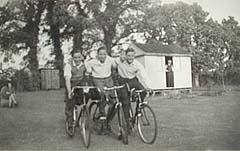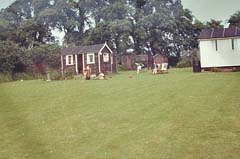Autumn, 1984: last days . . . . .
The pictures and notes below by courtesy of Mark McManus.
Mark and his daughter, Emily, have created valuable documentation of the remains of the Plotlands before final obliteration. Although he had not personally experienced life in the Plotlands in its prime, like many later visitors, Mark was struck by the unique atmosphere of a vanished community. Here are his impressions on discovering a derelict shack in the undergrowth between Fourth Avenue and the Poultry Farm.
February 1984, Dunton Hills, Essex: "Blackthorn"
I first see it as a deformity, a thing not belonging, an object interfering with the mind's perception of what the undergrowth should look like. Brittle shards of blackthorn peck at my skin as I squeeze through deep, dank foliage; the ravages of Winter leave their mark, the leaf mould clinging to my shoes, the morose silence of the scrubby woodlands broken by the occasional flight of alarmed woodpigeons from the forlorn arboreal canopy, my own laboured breathing clouding the chill air.
When first my eyes alight upon the shack, I halt and stare, not fully comprehending. In this close, wild scrubland, a small and decrepit building jars at the sensibilities. This should be a human thing, a sign of mankind's one-time presence, a symbol of Arcadian endeavour... but it seems unworldly, unnatural, as though it has sprung from the soil itself, a tree in twisted form, as though nature - having reclaimed the efforts of Man to impose a rustic lifestyle - is now mocking those efforts through mimicry. This is a vista Puck would have enjoyed, the remnant of a lost village looming through the trees.
The shack leans at an awkward angle as its lower courses gradually rot through damp. Blind, sightless windows, long denuded of glass, stare blankly at views long since obscured. A skewed rectangle of space proves the past existence of a door. Privacy has forgotten this small building. Nature has claimed it, ridiculed it, allowed it to stand as a testament to the vanity and precociousness of the human mind. I glance over my shoulder but my perspective is limited by the swathes of tangled haw and blackthorn I have just struggled through. The path I left several minutes ago is completely obscured, part of a different world, a dimension where human creation still holds sway.
The shack beckons, tempts, mocks. Through the creaking doorway, into a single room, traces of colour on the walls, a dappled mixture of curling paint, mildew and lichen. The floor is soft, mulched paper, twisted and rotted slivers of wood that once passed as furniture. Years have lapsed since this place was a holiday home, a sylvan retreat from the oppressiveness of the Smoke, a place to which its owners would flee on a Friday evening, tearing along the railway line from London to this portion of South Essex. Yet they are not quite departed. Their wraiths remain, so long as the shack remains. The human touch, faded and forsaken, dabs at this small space that nature has reclaimed.
Bones. Mixed with the shattered scatter of wood are damp, dull bones, mummified skin still stretched over the joints. What has happened here? Why is there the remains of a pet, a family dog, buried under this detritus? Another mystery, a chill enigma, a historic riddle that will never be answered. A few years from now the shack will be gone, foundations and a few charred remnants as its memorial, static on the leafy woodland floor while each passing season renders it an archaeological curiosity for the future, and the woods will be a popular Nature Reserve.
Yet nothing is really reserved about Nature. Defy it, attack it, scorn it, and as soon as your back is turned it will creep up and reclaim its dominion. The brief, half-century lifespan of the shack will be a blip in the history of the woods, but Nature is eternal.
Mark McManus
"Colin", Crest Avenue; seriously damaged
by fire in the autumn of 1983, owned by the Cakebread family of Canning
Town. Their relatives, the Howsons, owned "Rose Ville" at
the junction of Margaret Avenue and Beech Hall Gardens.
"Hawthorn", Hillcrest
Avenue; owned by the Burke family until 1983, when it became a home
for the wardens of The Haven Plotland Museum. It fell out of use
following the construction of the visitors' centre and was demolished in
1999.
A shack in Arcadian Gardens, only a few months
after dereliction, used by the Hibell family of Limehouse.
"Chook-A-Berry", Western Avenue; occupied by the Bletch
family until its destruction in late 1984.
"Grangewood", Beech hall
gardens; occupied by the Hayball family until late 1984.
Beech Hall Gardens, showing one of the
thin paths built by the plotlanders for their shopping trolleys.
"Grangewood" is on the left.
"Glencrest" at the junction
of Glenwood Gardens and Crest Avenue. A holiday home at the time of
its demolition in summer 1984, it was once a home to the Hinchcliff family
(electoral register, 1964). Its nameplate is an exhibit in the
plotland museum.
"Thorngrove", First
Avenue; occupied by the Thompson family until 1992. Its
remains are still highly visible.
Overgrown by scrub, a derelict shack
to the rear of the remains of "Anthelen", Fourth Avenue, owned
by a Mr Anthony of North London.
"High Trees" and "Four
Elms", Hillcrest Avenue; the overgrown patch in the garden is
the remains of an air-raid shelter; used by the Joyner family until 1985.
The derelict "Rosemary",
Highland Gardens; despite its diminutive size, it was once a
residence for the Wallace family (electoral register, 1964); collapsed in
1985.
"Viewgrand", Hillcrest
Avenue; destroyed in 1985, the small chimney is still visible on the
site; not "Iona" as the leaflet for the
plotland trail suggests!
"Iona", Hillcrest Avenue; owned by a local man, demolished in
summer, 1984. The nameplate can be viewed at the museum.
"Everest", First
Avenue; originally a shop, it was home to the Elliott family until
demolition in 1985.
"Maple Leaf", Berry Drive; originally
home to the Seeley family (electoral register 1949), later to Ernest
South. His neighbour at "Ruby", whom he mysteriously
called Ada, was actually named Rose Frasi. "Maple Leaf"
was demolished in summer, 1984, but its nameplate survives in the plotland
museum.

